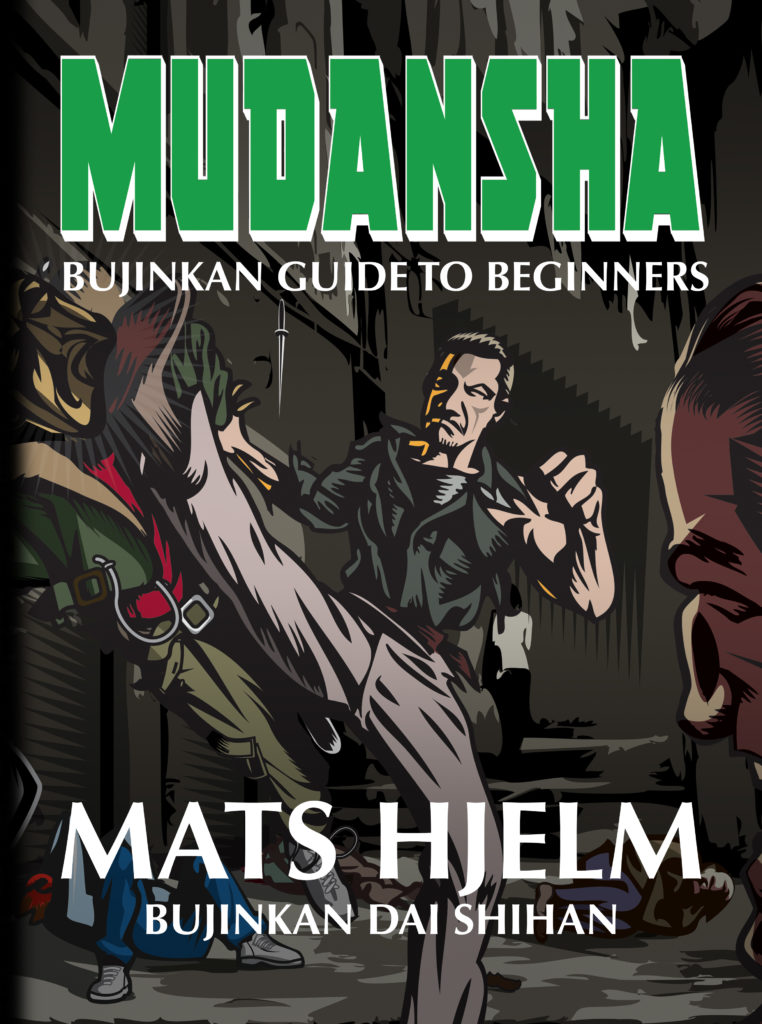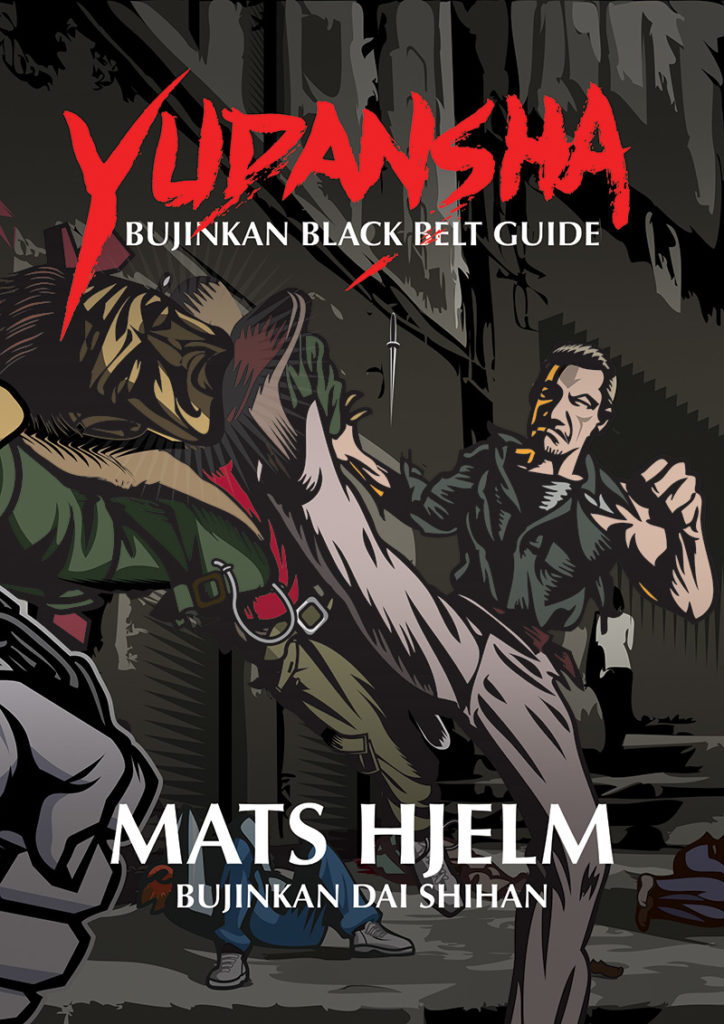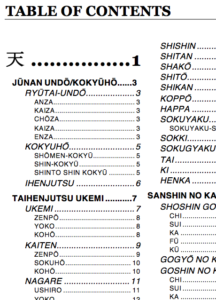 20% DISCOUNT
20% DISCOUNT 
YUDANSHA & MUDANSHA Book
Black Friday and Christmas discount for the rest of 2018, this is this years Bujinkan Christmas present. Get it at LULU.COM


 20% DISCOUNT
20% DISCOUNT 
YUDANSHA & MUDANSHA Book
Black Friday and Christmas discount for the rest of 2018, this is this years Bujinkan Christmas present. Get it at LULU.COM


The Second edition v3.1 (Released July 2018) IS OUT NOW!
It is also available as coil bound to make it more practical to use in the dojo. In the future there will also be a luxury version with full colour on all pages and hard cover for real hard core collectors.
The direct link to Lulu with all the book versions is http://bit.ly/yudansha
I found these errors, and made these changes to the new edition.
Errata for the First edition v3.0 (Released May 2018)
Please write a review what you think about the book, I really appreciate that! Thank’s Norman for your kind words.

The direct link to Lulu with all the book versions is http://bit.ly/yudansha
 After you read the book, please give us a fair review of the book. Did you like it? What did you like? Didn’t you like it? Why didn’t you like it? Would you recommend it? Or just write anything you honestly think about the book. Also try to be helpful to other people judging wether to buy this book or not.
After you read the book, please give us a fair review of the book. Did you like it? What did you like? Didn’t you like it? Why didn’t you like it? Would you recommend it? Or just write anything you honestly think about the book. Also try to be helpful to other people judging wether to buy this book or not.
Thank You and HAPPY TRAINING!
/Mats
 武神館無段者の案内所
武神館無段者の案内所
MUDANSHA – BEGINNERS GUIDE TO BUJINKAN
Prints in 3-5 business days
Click button below to order
English, Perfect-bound Paperback, 96 pages richly illustrated with pictures and illustrations.
This book is a guide for beginners in the Bujinkan Dojo. Everything about the rules and expectations of you as a pratctitioner, etiquette and traditions as well as the most fundamental techniques in our beautiful art.
About the Author: Mats have been training Bujinkan Budo-taijutsu since the early 1980’s. He travelled all around the world to train and teach Bujinkan Budo-taijutsu. http://YudanshaBook.com
Print details: 6″ x 9″, perfect binding, white interior paper (60# weight), black and white interior ink, white exterior paper (90# weight), full-color exterior ink.
 武神館有段者の案内所
武神館有段者の案内所
YUDANSHA – BUJINKAN BLACK BELT GUIDE
List Price: $27.77
Introduction Price: $22.22
You Save: $5.55 ( 20% )
Prints in 3-5 business days
English, Perfect-bound Paperback, 184 pages richly illustrated with pictures and illustrations. (32 483 Words, 145 533 Characters)
This book is a comprehensive guide to understand the Taijutsu of the Bujinkan system as taught by Masaaki Hatsumi Soke. We have this concept of Shu-Ha-Ri which is three major processes to learn Budo. First, we learn the fundamentals, then how to break them up. Then you transcend to a state where you are totally free without even thinking of what you are doing. Needless to say, you can’t get to the last stage without knowing the first stage well. It is said that you should study each level for at least 10 years. This book is all about the first stage we call Shu. It is further divided into three levels.
About the Author: Mats have been training Bujinkan Budo-taijutsu since the early 1980’s. He travelled all around the world to train and teach Bujinkan Budo-taijutsu. http://YudanshaBook.com
Print details: 8.26″ x 11.69″ (EU Standard A4), perfect binding, white interior paper (60# weight), black and white interior ink, white exterior paper (90# weight), full-color exterior ink.
The last Friday I asked Sōke if it was ok to publish this book, he said Gambatte before the translation was done. Then he looked through the book quickly and encouraged me to do it. Then it was painting time and I gave him a paper and asked for Yūdansha the book title. He wanted more paper and wrote the same phonetic sound but with different kanji. So I got three versions, like a 三心 Sanshin.
On Sunday (today) I got help finding the right kanji by Noguchi Sensei, then I did some internet research (no thanks to G00g1e that think Yūdansha means a “stepped-out person” (I guess they mean a LSD tripped out person 🙄), don’t tell them!).
有段者 YŪDANSHA is the normal kanji used which means a person that has a Dan rank (black belt).
If we break up the three kanji we get
有 YŪ (possess, have, exist, happen, occur, approx).
段 DAN (grade, steps, stairs)
者 SHA (someone, person).
勇段者 YŪDANSHA It could mean a black belt hero, a courageous or brave black belt
勇 YŪ (courage, cheer up, be in high spirits, bravery, heroism)
雅段者 YŪDANSHA it could mean an elegant, graceful or refined black belt.
雅 MIYABI (refinement; elegance; grace)
All this gave me a great idea to incorporate this in the book. I’m not gonna go further here as the book is unwritten and I might change my mind. But I feel that the book is gonna be something different than all the others and something I will be proud of.
First draft of the book cover. I will change the font of “YUDANSHA” on the front page, or I might even draw it as art. If I do it I’ll save it as a collectors item for later, maybe auction for charity or something?
The artwork was done for me by Aidan Hughes (BRUTE).
What do you think?
Hello!
My name is Mats Hjelm and I have been training Bujinkan Budo Taijutsu under Masaaki Hatsumi Sōke for the past 35 years or so. Read more about me here.
All the time since I started training I’ve been keeping notes that progressively became manuals and then books. First they was for myself, then to my students and now I thought it is time to make it public.
So here is the first book coming, it is all about the basics, something I wish I had when I started training. Bujinkan is a huge system with many schools (ryū-ha (traditions)) and it would be impossible to cover everything in a book. Hatsumi Sōke published many books, videos and publications (I collected and have almost all of them). Every time I learned something new I added it to my own notes. The purpose of this book is to be a training guide, reference and help for everyone training in Bujinkan Budo Taijutsu, from beginners up to 5’th Dan.
What is covered in this book is
Etiquette and traditions that will help everyone to get comfortable in the Dōjō, from what are we saying in the starting and closing ceremony and what does it mean and why. What is the official uniform, how do I tie the belt so it looks like I’m a pro. How do I bow not looking like Karate Kid. Understanding the Rules of the Bujinkan. How to not look like a fool in front of others in the Dōjō and. And much more.
Techniques
The whole Ten-Chi-Jin Ryaku no maki which is the three levels of techniques most Bujinkan Dōjō use. There have been a few different versions through all the years. I have included all of them and rearranged some, and even added a few more techniques to make it more representative. For example there was only one Muto-dori technique (I added two more), there was only three seated techniques (I added two more). There is a concept of Kihon technique which is the basic way of doing a described technique, sometimes they added 1-5 Ura-Waza to each Kihon technique to add more examples. I added two Ura-waza to each Kihon Happy technique, and a few other techniques to give beter understanding to the techniques. This is not to be confused with Henka which is never written down in the Densho. Henka is more spontaneous techniques you do because you have to, it is like adjusting because what you started doing will not work. There are thousands Henka to each technique and pointless to even try to describe.
When and if the book is released I will add the full content list here.
But first I will show Hatsumi Sōke on my next trip in January 2018 what I’ve done and ask for his permission to release the book. I can understand if he says no, I’ve put 35 years into this book and maybe you don’t deserve to get everything so easy. Maybe it will trap you in my way of thinking and it is better if everyone evolve without too much influence (I don’t know). Anyway it is the correct way I think.
I’ll keep you updated here and on twitter.
Happy Training!
/Mats